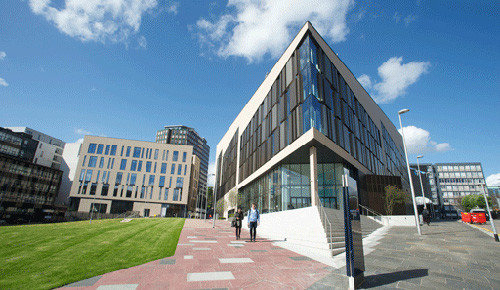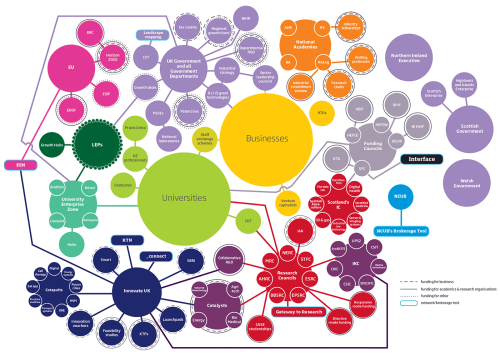
Glasgow’s Technology and Innovation Centre. (Courtesy: University of Strathclyde)
By Margaret Harris in Glasgow
If you’re the first speaker after lunch at a conference, how do you make sure your audience stays awake and engaged?
For Oliver Ambacher – who occupied the dreaded post-prandial slot during Wednesday’s applied photonics conference at Glasgow’s Technology and Innovation Centre (TIC) – the answer is simple. You pretend to jump off a cliff.
Ambacher, the director of the Fraunhofer Institute for Applied Solid State Physics in Freiburg, Germany, made his leap (actually, several leaps of varying lengths) to illustrate one of the toughest challenges in applied physics: the yawning gap between what academic researchers can provide, and what industry scientists need to turn that research into innovative products. This gap is sometimes called the “valley of death”, and Ambacher’s point was that the risks of leaping across it are generally higher on the industry side. “If I, whose heart is still in physics, jump into the valley of death, I lose funding, maybe a project,” Ambacher explained. “But somebody from industry, they may lose their job. So they cannot jump so far.”
Ambacher’s athletic illustration of the valley of death met with appreciative nods from audience members, who had gathered in the TIC to celebrate the 20th anniversary of the Institute of Photonics. The institute and the TIC are both part of the University of Strathclyde, and each of them is, in its own way, a response to the challenge Ambacher described: the institute’s 10 principal investigators all do industrially relevant photonics research, while the TIC is home to more than a dozen groups working on applied science and engineering.
The other speakers at the day-long conference hailed from both sides of the academia–industry interface. Andrew Bennett of the industrial-diamonds firm Element Six spoke about using sheets of polycrystalline diamond as heat sinks for high-powered lasers. Stefan Illek of Osram Opto Semiconductors described how high-current, high-luminosity LEDs are replacing halogen lamps in car headlights – making it much easier to produce beams that change their shape in response to other cars (so no more accidentally blinding the oncoming traffic with your high beams).
Illek’s presentation was followed by a wide-ranging talk from Volkan Demir of NTU Singapore, in which he described how materials that incorporate semiconductor quantum dots could eventually replace scarce and expensive rare-earth metals in certain applications (the consumer-electronics giant Samsung is one of his many industrial collaborators). And the last two speakers of the afternoon session had even more ambitious goals for their industry–academia collaborations: Harald Haas of the University of Edinburgh is out to reinvent the Internet using LED light bulbs (“LiFi” instead of WiFi), while Stanford’s Daniel Palanker wants to use optoelectronics to restore sight to people with blindness.

The Dowling Report’s research and innovation funding landscape map. Click to enlarge. (Crown copyright, Open Government Licence v3.0)
The conference’s final speaker, however, sounded a cautionary note. As the president of the Royal Academy of Engineering, Ann Dowling chaired a recent review of the status of business–university research collaboration in the UK. During this review, Dowling found that “academics who pursue collaborations with industry often do so in spite of, not because of, their universities”, while the chief technology officers of several major firms confessed that when it came to asking universities for help, they didn’t even know where to start. The complexity of the UK’s “funding landscape” for industrially relevant research is a major barrier, Dowling said, adding that the sprawling diagram shown above doesn’t even cover every organization that works in this area.
If only it were as simple as taking a running start before leaping…
Guidelines
Show/hide formatting guidelines
this text was deletedwhere people live in harmony with nature and animals</q>
Some text